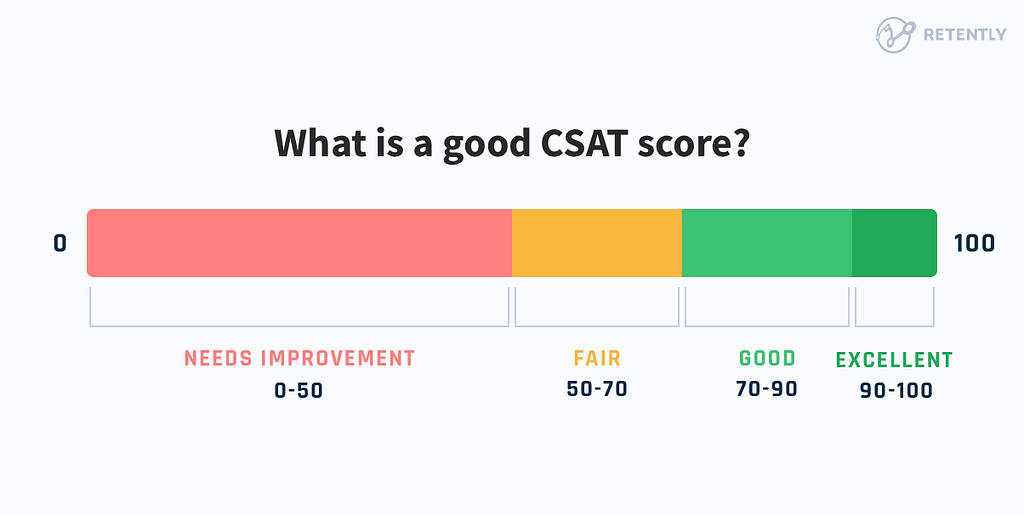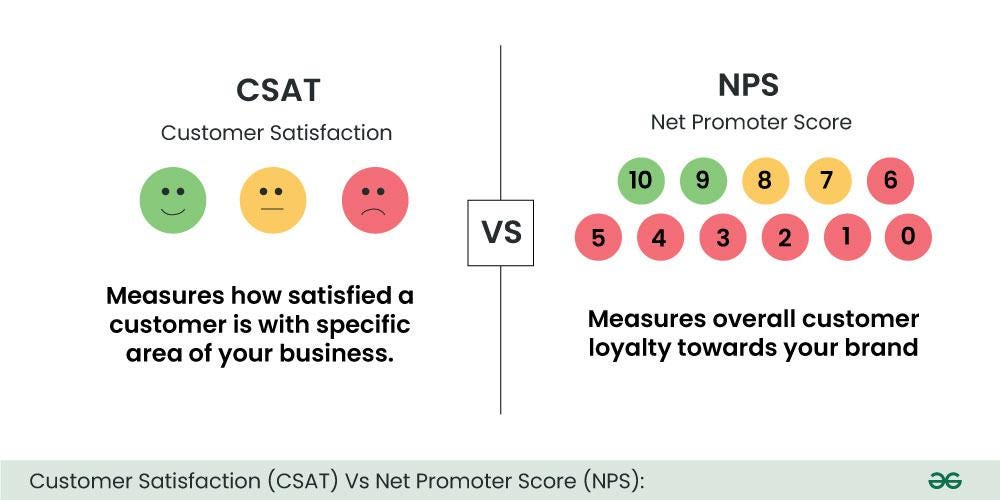
Customer Satisfaction Score (CSAT) is a commonly used metric to gauge how satisfied customers are with a product or service.
How CSAT is calculated
Typically, customers are asked a simple question like“How satisfied are you with our product? Rate it on a scale from 1–10 (1 = Not Satisfied at All, 10 = Extremely Satisfied)”
Satisfied customers are those who select the highest score (e.g.,7–10).


Here is an example of CSAT calculation. Suppose you have 200 respondents, and 160 respondents give your product/service a high score.
CSAT = (160/200) x 100 = 80%
Benefits of CSAT
- Simplicity: Easy to add to your product, easy to calculate.
- Real-time insights: CSAT helps to collect user feedback on specific interactions or aspects of your service.
Limitations
- Subjective: Results depend on customers’ perception of your product, which can be influenced by personal factors (i.e., opinions the user has about a product). Based on my observations, users are less likely to respond to CSAT if they’re unhappy.
- Not comprehensive: Focuses on satisfaction without delving into loyalty or overall brand perception.
- Short-term view: CSAT captures immediate satisfaction but might not reflect long-term customer relationships or brand perception.
Just because customers say that they’re happy with your product at the moment doesn’t mean that they’ll become your loyal audience.
When to collect CSAT
Ideally, users should be prompted to share their satisfaction level right after the key interaction, such as:
- After customer support: Following a service interaction like resolving an issue.
- After product delivery (eCommerce): Once the customer has received their product.
- After a milestone/service completion: For example, after training or consultation.
Collect CSAT within 24–48 hours after the interaction while the experience is fresh.
While it’s possible to collect CSAT in real-time (i.e., embedded surveys that collect feedback while users interact with a service), this is not a very effective way of prompting for feedback because many times, users will avoid filling out any surveys while they have active tasks at hand.
Practice a non-intrusive approach—avoid interrupting customers during critical activities like shopping or checkout.
It is also not recommended to prompt users for CSAT right at the very beginning of using a new product (such as after onboarding) — not only because the feedback that users provide is prone to bias (simply because users don’t have enough time to experience the product), it introduces a roadblock for using a product.
A slightly more effective way of collecting CSAT can be a periodic survey that you send as emails to your customers. Such surveys can help you understand ongoing satisfaction trends. Just be ready that a very small percentage of users will fill out this survey (<10% of all customers who receive email).
How to mitigate CSAT downsides
To get a holistic view of user experience, it is recommended to pair CSAT with other metrics such as Net Promoter Score (NPS), Customer Effort Score (CES), or Customer Lifetime Value (CLV).

It is also recommended to include open-ended questions such as “What could we improve?” to gain actionable insights when a user gives a low score.
Last but not least, you should look at CSAT trends rather than isolated scores to identify patterns. Break down CSAT by demographics, touchpoints, or customer journey stages to gain deeper insights.
🚨 New course alert! 🚨
I’m designing a course on Measuring Design — techniques, strategies and tools that will help you quantify design impact. 🎨📊
Help me shape it by filling out this quick survey! 📝👇
https://maven.com/forms/a2e577
Customer Satisfaction Score (CSAT): Essentials was originally published in UX Planet on Medium, where people are continuing the conversation by highlighting and responding to this story.